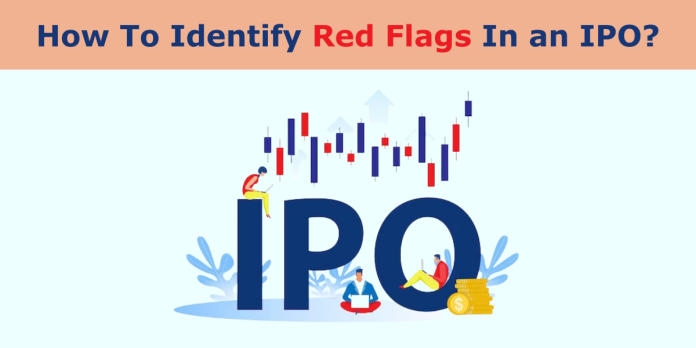Investing in an Initial Public Offering (IPO) can be an exciting and potentially lucrative opportunity for investors. However, it also comes with significant risks. To make informed decisions, it’s essential to be able to identify red flags in an IPO. These warning signs can help you avoid potential pitfalls and protect your hard-earned money. In this blog, we will discuss some critical factors to consider when evaluating an IPO for potential red flags.
Lack of a Clear Business Model
One of the most significant red flags in an IPO is when a company lacks a clear and well-defined business model. A well-defined business model should explain how the company generates revenue, its target market, and its growth strategy. If the company’s prospectus is vague or overly complex, it could indicate a lack of transparency and raise concerns about the company’s long-term viability.
Weak Financials
Analysing a company’s financial statements is a crucial part of evaluating an IPO. Red flags can appear in various financial metrics:
- Revenue and Profit Trends: Look for consistent revenue and profit growth over the past few years. If the company has declining or erratic financial performance, it could be a red flag. Additionally, if the company is reporting profits which are close to zero, it is possible that the company might have done some financial shenanigans.
- High Debt Levels: Excessive debt can be a sign of financial instability. Check the company’s debt-to-equity ratio to assess its financial health.
- Negative Cash Flow: Negative cash flow can indicate that the company is burning through cash faster than it can generate it. This is unsustainable in the long term.
Lack of Competitive Advantage
A sustainable competitive advantage is essential for a company’s long-term success. If the IPO prospectus doesn’t clearly identify the company’s competitive edge, it could be a red flag. Look for information on patents, proprietary technology, brand recognition, or unique market positioning.
Insider Selling
When a significant number of insiders, such as founders and early investors, are selling their shares during the IPO, it might suggest a lack of confidence in the company’s future prospects. This can be a red flag, as insiders typically have a better understanding of the company’s true value.
Regulatory Issues and Litigation
Check if the company is facing any regulatory issues or is involved in ongoing litigation. Legal troubles can have a substantial impact on a company’s finances and reputation. Review the IPO prospectus and news reports for any pending lawsuits or regulatory investigations.
Lack of Transparency
A lack of transparency can be a major red flag in an IPO. Investors should have access to comprehensive information about the company’s operations, risks, and financials. If the prospectus is lacking in detail or seems overly promotional, it’s essential to be cautious.
Overly Aggressive Valuation
A company’s valuation is a critical aspect of an IPO. If the company is priced too high compared to its peers or its financial performance, it could be overvalued. An overly aggressive valuation may lead to disappointing returns for investors.
Unproven Management Team
The management team is a crucial factor in a company’s success. If the IPO lacks experienced and capable leadership, it can be a red flag. Assess the backgrounds and track records of the company’s executives and directors.
Unpredictable Market Conditions
IPOs are sensitive to market conditions. A red flag can be raised if the IPO market is turbulent, with high volatility or an economic downturn. These conditions can affect the demand and pricing of the IPO.
Conclusion
Investing in an IPO can be a rewarding venture, but it also carries inherent risks. Identifying red flags is crucial for minimizing those risks and making informed investment decisions. By carefully scrutinizing factors like the company’s business model, financials, competitive advantage, insider selling, regulatory issues, transparency, valuation, management team, and market conditions, investors can better navigate the IPO landscape. It’s advisable to seek advice from financial experts and conduct thorough due diligence before committing your capital to any IPO.
Remember, while red flags are warning signs, they do not guarantee the outcome of your investment. Careful analysis and prudent decision-making are your best tools for success in the IPO market.
Disclaimer: This blog has been written exclusively for educational purposes. The securities mentioned are only examples and not recommendations. It is based on several secondary sources on the internet and is subject to changes. Please consult an expert before making related decisions.


